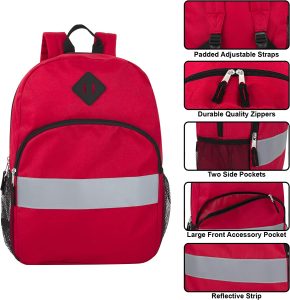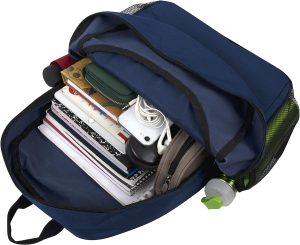1. Nylon:
- Nylon is a popular choice due to its durability, abrasion resistance, and water resistance.
- It’s available in various denier (D) ratings, indicating the fabric’s thickness and strength. Higher denier fabrics are generally more durable.
- Ripstop nylon includes reinforcing threads that help prevent tears from spreading.
2. Polyester:
- Polyester is known for its durability, colorfastness, and resistance to UV rays.
- It’s often used in backpacks for its strength and ability to retain color.
- Polyester blends may combine durability with added stretch or water resistance.
3. Cordura:
- Cordura is a type of nylon fabric known for its exceptional abrasion resistance and durability.
- It’s commonly used in backpacks designed for outdoor and rugged use.
4. Dyneema (Cuben Fiber):
- Dyneema is an ultralight and incredibly strong synthetic material.
- It’s known for its high tear strength, water resistance, and minimal weight.
- Dyneema backpacks are often used in ultralight and technical outdoor pursuits.
5. Canvas:
- Canvas is a heavy-duty fabric that’s durable and offers a classic look.
- While not as lightweight as modern synthetic materials, canvas is known for its ruggedness and longevity.
6. PU-Coated and Silicone-Coated Fabrics:
- Fabrics coated with polyurethane (PU) or silicone provide water resistance while maintaining flexibility.
- PU-coated fabrics are more common and affordable, while silicone-coated fabrics offer increased durability and lighter weight.
7. Waterproof vs. Water-Resistant:
- Waterproof materials, often with taped seams, prevent water from entering the backpack even in heavy rain.
- Water-resistant materials repel water to a certain extent but may not withstand prolonged exposure.
8. Zippers and Hardware:
- Look for YKK zippers or other reputable brands, as they’re known for durability.
- Reinforced stitching and heavy-duty hardware enhance the backpack’s overall strength.
9. Mesh Panels:
- Backpacks often include mesh panels for ventilation and breathability.
- Mesh durability can vary, and high-denier or reinforced mesh is more resilient.
10. Leather Accents: – Leather accents can add a stylish touch to a backpack, but leather requires care and maintenance to remain durable over time.
When assessing a backpack’s durability based on its materials, consider the type of activities you’ll be engaging in, the terrain you’ll encounter, and the conditions you’ll face. Balance your need for durability with other factors like weight, style, and comfort. Reading reviews and understanding the specific denier ratings or fabric treatments can help you make an informed decision about the durability of the backpack that best suits your needs.

















